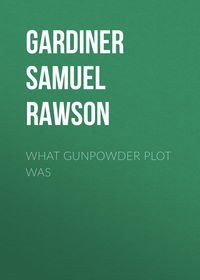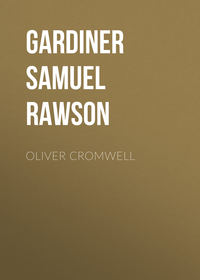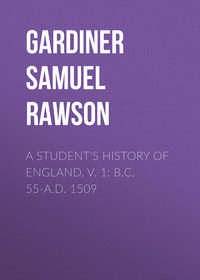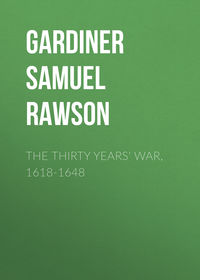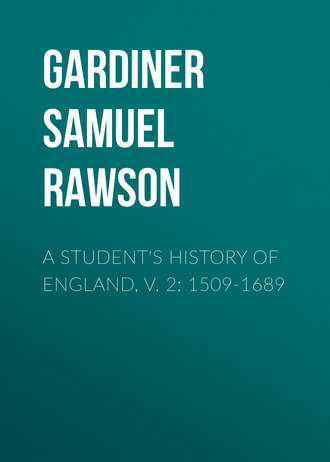 полная версия
полная версияA Student's History of England, v. 2: 1509-1689
25. Presbyterians and Independents. 1644.– Cromwell spoke of Marston Moor as a victory of the 'godly party.' The Westminster Assembly of Divines had declared strongly in favour of Presbyterianism, but there were a few of its members – only five at first, known as the five Dissenting Brethren – who stood up for the principles of the Separatists (see p. 470) wishing to see each congregation independent of any general ecclesiastical organisation. From holding these opinions they were beginning to be known as Independents. These men now attracted to themselves a considerable number of the stronger-minded Puritans, such as Cromwell and Vane, of whom many, though they had no special attachment to the teaching of the Independent divines, upheld the idea of toleration, whilst others gave their adherence to one or other of the numerous sects which had recently sprung into existence. Cromwell, especially, was drawn in the direction of toleration by his practical experience as a soldier. It was intolerable to him to be forbidden to promote a good officer on the ground that he was not a Presbyterian. On one occasion he was asked to discard a certain officer because he was an Anabaptist. "Admit he be," he had replied; "shall that render him incapable to serve the public? Take heed of being too sharp, or too easily sharpened by others, against those to whom you can object little but that they square not with you in every opinion concerning matters of religion." He had accordingly filled his own regiments with men of every variety of Puritan opinion, choosing for promotion the best soldier, and not the adherent of any special Church system. These he styled 'the godly party,' and it was by the soldiers of 'the godly party,' so understood, that Marston Moor had been won.
26. Essex's Surrender at Lostwithiel. 1644.– Essex was the hope of the Presbyterians who despised the sects and hated toleration. Being jealous of Waller, he left him to take Oxford alone, if he could, and marched off to the West, to accomplish what he imagined to be the easier task of wresting the western counties from the king. Charles turned upon Waller, and fought an indecisive action with him at Cropredy Bridge, after which Waller's army, being composed of local levies with no heart for permanent soldiering, melted away. Charles then marched in pursuit of Essex, and surrounded him at Lostwithiel, in Cornwall. Essex's provisions fell short; and on September 2, though his horse cut their way out, and he himself escaped in a boat, the whole of his infantry capitulated.
27. The Second Battle of Newbury. 1644.– London was thus laid bare, and Parliament hastily summoned Manchester and the army of the Eastern Association to its aid. Manchester, being good-natured and constitutionally indolent, longed for some compromise with Charles which might bring about peace. Cromwell, on the other hand, perceived that no compromise was possible with Charles as long as he was at the head of an army in the field. A second battle of Newbury was fought, on October 27, with doubtful results: Manchester showed little energy, and the king was allowed to escape in the night. Cromwell, to whom his sluggishness seemed nothing less than treason to the cause, attacked Manchester in Parliament, not from personal ill-will, but from a desire to remove an inefficient general from his command in the army. Two parties were thus arrayed against one another: on the one side the Presbyterians, who wanted to suppress the sects and, if possible, to make peace; and on the other side the Independents, who wanted toleration, and to carry on the war efficiently till a decisive victory had been gained.
CHAPTER XXXV
THE NEW MODEL ARMY. 1644-1649
LEADING DATESReign of Charles I., 1625-1649• Battle of Naseby June 14, 1645
• Glamorgan's Treaty Aug. 25, 1645
• Charles in the hands of the Scots May 5, 1646
• Charles surrendered by the Scots Jan. 30, 1647
• Charles carried off from Holmby June 5, 1647
• The Army in Military Possession of London Aug. 7, 1647
• Charles's Flight from Hampton Court Nov. 11, 1647
• The Second Civil War April to Aug., 1648
• Pride's Purge Dec. 6, 1648
• Execution of Charles Jan. 30, 1649
1. The Self-denying Ordinance and the New Model. 1645.– Cromwell dropped his attack on Manchester as soon as he found that he could attain his end in another way. A proposal was made for the passing of a Self-denying Ordinance,23 which was to exclude all members of either House from commands in the army. The Lords, knowing that members of their House would be chiefly affected by it, threw it out, and the Commons then proceeded to form a New Model Army – that is to say, an army newly organised, its officers and soldiers being chosen solely with a view to military efficiency. Its general was to be Sir Thomas Fairfax, whilst the lieutenant-general was not named; but there can be little doubt that the post was intended for Cromwell. After the Lords had agreed to the New Model, they accepted the Self-denying Ordinance in an altered form, as, though all the existing officers were directed to resign their posts, nothing was said against their re-appointment. Essex, Manchester, and Waller resigned, but when the time came for Cromwell to follow their example, he and two or three others were appointed to commands in the new army. Cromwell became Lieutenant-General, with the command of the cavalry. The New Model was composed partly of pressed men, and was by no means, as has been often said, of a sternly religious character throughout; but a large number of decided Puritans had been drafted into it, especially from the army of the Eastern Association; and the majority of the officers were Independents, some of them of a strongly Sectarian type. The New Model Army had the advantage of receiving regular pay, which had not been the case before; so that the soldiers, whether Puritans or not, were now likely to stick to their colours.
2. Milton's 'Areopagitica.' 1644.– By Cromwell, who in consequence of his tolerance was the idol of the Sectarians in the army, religious liberty had first been valued because it gave him the service of men of all kinds of opinions. On November 24, 1644, Milton, some of whose books had been condemned by the licensers of the press appointed by Parliament, issued Areopagitica, in which he advocated the liberty of the press on the ground that excellence can only be reached by those who have free choice between good and evil. "He that can apprehend," he wrote, "and consider vice with all her baits and seeming pleasures, and yet abstain – he is the true warfaring Christian. I cannot praise a fugitive and cloistered virtue, unexercised and unbreathed, that never sallies out and seeks her adversary, but slinks out of the race, when that immortal garland is to be run for, not without dust and heat." Liberty was good for religion as much as it was for literature. "These are the men," he continued, "cried out against for schismatics and sectaries, as if, while the temple of the Lord was building, there should be a sort of irrational men who could not consider there must be many schisms and many dissections made in the quarry and in the timber ere the house of God can be built." The perfection of the building consisted "in this – that out of many moderate varieties and brotherly dissimilitudes that are not vastly disproportional, arises the goodly and the graceful symmetry that commends the whole pile and structure."
3. The Execution of Laud. 1645.– In Parliament, at least, there was one direction in which neither Presbyterian nor Independent was inclined to be tolerant. They had all suffered under Laud, and Laud's impeachment was allowed to go on. The House of Lords pronounced sentence against him, and on January 10, 1645, he was beheaded. The Presbyterians had the majority in the House of Commons, and they were busy in enforcing their system, as far as Parliamentary resolutions would go. The Independents had to wait for better times.
4. Montrose and Argyle. 1644.– For the present, however, the two parties could not afford to quarrel, as a powerful diversion in the king's favour was now threatening them from Scotland. The Marquis of Montrose, who, in the Bishops' Wars, had taken part with the Covenanters, had grown weary of the interference of the Scottish Presbyterian clergy with politics, and still more weary of the supremacy in Scotland of the Marquis of Argyle, who had all the organisation of the Presbyterian Church at his disposal. Montrose saw that, though Argyle was too strong for him in the Lowlands, it was possible to assail him with effect in the Highlands, where he had made many enemies. In the Lowlands Argyle was regarded as a Scottish nobleman. In the Highlands he was the chief of the clan of the Campbells, which had often unscrupulously extended its borders at the expense of its neighbours, especially at the expense of the various clans of the Macdonalds. Montrose therefore hoped that if he threw himself into the Highlands, he might make use of the enmity of these clans against the Campbells to crush Argyle and to exalt the king.
5. Montrose in the Highlands. 1644-1645.– In 1644, shortly after the battle of Marston Moor, Montrose made his way to the Highlands with only two followers. He was the first to discover the capacity of the Highlanders for war. With their help, and with the help of a trained Irish contingent, mostly composed of the descendants of Highlanders who had emigrated to Ireland, he beat the Scottish forces at Tippermuir and Aberdeen, and then, crossing the mountains, amidst the snows of winter, harried the lands of the Campbells. On February 2, 1645, he defeated Argyle's clansmen at Inverlochy, whilst Argyle himself – who was no warrior – watched their destruction from a boat. Wherever Montrose went the heavy Lowland troops toiled after him in vain. On May 9 he overthrew another army under Baillie at Auldearn. Leven's Scottish army in Yorkshire had enough to do to bar the way against Montrose in case of his issuing from the mountains and attempting to join forces with Charles in England. With any other troops Montrose would probably have made the attempt already; but his Highlanders were accustomed to return home to deposit their booty in their own glens as soon as a battle had been won, and, therefore, victorious as he had been, he was unable to leave the Highlands.
6. The New Model Army in the Field. 1645.– The New Model army started on its career in April. Cromwell, with his highly-trained horse, swept round Oxford, cutting off Charles's supplies; whilst Fairfax was sent by the Committee of Both Kingdoms (see p. 542) to the relief of Taunton, which had been gallantly holding out under Robert Blake. A detachment of Fairfax's force sufficed to set Taunton free. His main force was stupidly sent by the Committee to besiege Oxford, though the king was marching northwards, and might fall upon Leven's Scots as soon as he reached them. On May 31, however, Charles turned sharply round, and stormed Leicester. The popular outcry in London compelled the Committee to allow their commander-in-chief to act on his own discretion; and Fairfax, abandoning the siege of Oxford, marched straight in pursuit of the Royal army.
7. The Battle of Naseby. 1645.– On June 14 Fairfax overtook the king at Naseby. In the battle which followed, the Parliamentary army was much superior in numbers, but it was largely composed of raw recruits (see p. 545), and its left wing of cavalry – under Ireton, who, in the following year, became Cromwell's son-in-law – was routed by the king's right, under Rupert. As at Edgehill, Rupert galloped hard in pursuit, without looking back. The Parliamentary infantry in the centre was by this time pressed hard, but Cromwell, on the right, at the head of a large body of cavalry, scattered the enemy's horse before him. Then, as at Marston Moor, he halted to see how the battle went elsewhere. Sending a detachment to pursue the defeated Royalists, he hurled the rest of his horse on the king's foot, who were slowly gaining ground in the centre. In those days, when half of every body of infantry fought with pikes, and the other half with inefficient muskets, it was seldom that foot-soldiers could withstand a cavalry charge in the open, and the whole of Charles's infantry, after a short resistance, surrendered on the spot. Rupert returned only in time to see that defeat was certain. The king, with what horse he could gather round him, made off as fast as he could. The stake played for at Naseby was the crown of England, and Charles had lost it.
8. The Results of Naseby. 1645.– Disastrous as Charles's defeat had been, he contrived to struggle on for some months. The worst thing that befel him after the battle was the seizure of his cabinet containing his correspondence, which revealed his constant intrigues to bring alien armies – French, Lorrainers, and Irish – into England. It was, therefore, in a more determined spirit than ever that Parliament carried on the war. After retaking Leicester, on June 18, Fairfax marched on to the West, where the king's eldest son, Charles, Prince of Wales, had been since the summer of 1644, and where debauched and reckless Goring was at the head of a Royalist army. On July 10 Fairfax routed him at Langport, and on July 23 took Bridgwater. Then, leaving forces to coop up Goring's remaining troops, Fairfax turned eastward, took Sherborne on August 2, whilst the Scots, who after Naseby had marched southwards, were besieging Hereford. On September 1, however, the king relieved Hereford, and fancied he might still retrieve his fortunes. On September 10, he received a severe blow. Fairfax stormed the outer defences of Bristol, and Rupert, who commanded the garrison, at once capitulated. There can be little doubt that he had no other choice; but Charles would hear no excuse, and dismissed him from his service.
9. Charles's Wanderings. 1645.– Charles's hopes were always springing up anew, and now that Rupert had failed him, he looked to Montrose for deliverance. Montrose, on July 2, had won another victory at Alford, and, on August 15, a still more crushing victory at Kilsyth, after which he had entered Glasgow, and received the submission of the Lowlands. Charles marched northward to meet him, but on the way was met and defeated by the Parliamentary general, Poyntz, on Rowton Heath. Almost immediately afterwards he heard the disastrous news that David Leslie, an able officer who had won renown in the German wars, and had fought well at Marston Moor, had been despatched from the Scottish army in England, had fallen upon Montrose at Philiphaugh, at a time when he had but a scanty following with him, and had utterly defeated him. After this Cromwell reduced the South, capturing Winchester and Basing House, whilst Fairfax betook himself to the siege of Exeter. In October, Charles, misled by a rumour that Montrose had recovered himself, made one more attempt to join him; but he was headed by the enemy, and compelled to retreat to Oxford, where, with all his followers ardently pleading for peace, he still maintained that his conscience would not allow him to accept any terms from rebels, or to surrender the Church of England into their hands.
10. Glamorgan in Ireland. 1645-1646.– Not one of Charles's intrigues with foreign powers did him so much harm as his continued efforts to bring over an Irish army to fight his battles in England. In 1645 he despatched the Roman Catholic Earl of Glamorgan to Ireland, giving him almost unlimited powers to raise money and men, and to make treaties with this object, but instructing him to follow the advice of Ormond. When Glamorgan arrived in Ireland, in August, he found that the Confederate Catholics were resolved to demand that all the churches in Ireland, except the few still in the hands of the English, should be given permanently to the Catholics, and that permission should be granted to their clergy to exercise jurisdiction in matters spiritual and ecclesiastical. Though Glamorgan knew that Charles had never approved of these concessions, he signed a treaty, on August 25, 1645, in which he granted all that was asked, in consideration of an engagement by the Confederates to place him at the head of 10,000 Irishmen destined for England. Before anything had been done, a Papal Nuncio, Rinuccini, landed in Ireland and required fresh concessions, to which Glamorgan readily assented. On January 16, 1646, however, before Glamorgan's army was ready to start, the treaty which he had made in August became known at Westminster; and, though Charles promptly disavowed having authorised its signature, there remained a grave suspicion that he was not as innocent as he pretended to be.
11. The King's Flight to the Scots. 1646.– In the beginning of 1646 the Civil War virtually came to an end. On March 14, Charles's army in the West surrendered to Fairfax in Cornwall, and in the same month the last force which held the field for him was overthrown at Stow-on-the-Wold. Many fortresses still held out, but, as there was no chance of relief, their capture was only a question of time; and though the last of them – Harlech Castle – did not surrender till 1647, there was absolutely no doubt what the result would be. Charles, now again at Oxford, had but to choose to whom he would surrender. He chose to give himself up to the Scots, whose army was at the time besieging Newark. He seems to have calculated that they would replace him on the throne without insisting on very rigorous conditions, thinking that they would rather restore him to power than allow the English army, formidable as it was, to have undisputed authority in England, and possibly to crush the independence of Scotland. The Scots, on the other hand, seem to have thought that, when Charles was once in their power, he must, for his safety's sake, agree to establish Presbyterianism in England, by which means the party which would of necessity lean for support on themselves would have the mastery in England. On May 5, 1646, Charles rode in to the quarters of the Scottish army at Southwell, a few miles from Newark.
12. Charles at Newcastle. 1646.– Newark at once surrendered, and Charles was conveyed to Newcastle, where, as he refused to consent to the establishment of Presbyterianism in England, he was practically treated as a prisoner. At the end of 1645 and the beginning of 1646 there had been fresh elections to fill up seats in the House of Commons left vacant by Royalists expelled for taking the king's part; but, though many Independent officers were chosen, there was still a decidedly Presbyterian majority. On July 14 propositions for peace were delivered to Charles on behalf of Parliament and the Scots. He was to surrender his power over the militia for twenty years, to take the Covenant, and to support Presbyterianism in the Church. Charles, in his correspondence with his wife, showed himself more ready to abandon the militia than to abandon episcopacy; whilst she, being a Roman Catholic, and not caring for bishops whom she counted as heretics, advised him at all hazards to cling to the command of the militia. Charles hoped everything from mere procrastination. "All my endeavours," he wrote to the queen, "must be the delaying of my answer till there be considerable parties visibly formed" – in other words, till Presbyterians and Independents were ready to come to blows, and, therefore, to take him at his own price. In order to hasten that day, he made in October a proposal of his own, in which he promised, in case of his being restored to power, to establish Presbyterianism for three years, during which time the future settlement of the Church might be publicly discussed. He, however, took care to make no provision for the very probable event of the discussion leaving parties as opposed to one another as they had been before the discussion was opened, and it was obvious that, as he had never given the royal assent to any Act for the abolition of episcopacy, the whole episcopal system would legally occupy the field when the three years came to an end. The Presbyterians would thus find themselves checkmated by an unworthy trick.
13. The Removal of the King to Holmby. 1647.– The Scots, discontented with the king's refusal to accept their terms, began to open their ears to an offer by the English Parliament to pay them the money owing to them for their assistance, on the open understanding that they would leave England, and the tacit understanding that they would leave the king behind them. Once more they implored Charles to support Presbyterianism, assuring him that, if he would, they would fight for him to a man. On his refusal, they accepted the English offer, took their money, and on January 30, 1647, marched away to their own country, leaving Charles in the hands of Commissioners of the English Parliament, who conveyed him to Holmby House, in Northamptonshire.
14. Dispute between the Presbyterians and the Army. 1647.– The leading Presbyterians, of whom the most prominent was Holles (see p. 535), were so anxious to come to terms with the king, that before the end of January they accepted Charles's illusory proposal of a three years' Presbyterianism (see p. 552), offering to allow him to come to London or its neighbourhood in order to carry on negotiations. The fact was, that they were now more afraid of the army than of the king, believing it to be ready to declare not merely for toleration of the sects, but also for a more democratic form of government than suited many of the noblemen and gentlemen who sat on the benches of the Lords and Commons. In March the Commons voted that only a small body of cavalry should be kept up in England, and no infantry at all, except a small force needed to garrison the fortresses, and also that when the infantry regiments were broken up the disbanded soldiers should be asked to volunteer for service in Ireland. Of the cavalry in England Fairfax was to be general, but no officer under him was to hold a higher rank than that of colonel, a rule which would enable Cromwell's opponents in Parliament to oust him from his position in the army. So strong was the feeling in the nation for peace, and for the diminution of the heavy burden of taxation which the maintenance of the army required, that the Presbyterians would probably have gained their object had they acted with reasonable prudence, as a large number of soldiers had no sympathy with the religious enthusiasts in the ranks. There were, however, considerable arrears of pay owing to the men, and had they been paid in ready money, and an ordinance passed indemnifying them for acts done in war-time, most, if not all, would, in all probability, either have gone home or have enlisted for Ireland. Instead of doing this, Parliament only voted a small part of the arrears, and fiercely denounced the army for daring to prepare a petition to Fairfax asking for his support in demanding full pay and indemnity. In a few weeks Parliament and army were angrily distrustful of one another, and the soldiers, organising themselves, chose representatives, who were called Agitators24 or agents, to consult on things relating to their present position.
15. Cromwell and the Army. 1647.– Cromwell's position during these weeks was a delicate one. He sympathised not only with the demands of the soldiers for full pay, but also with the demand of the religious enthusiasts for toleration. Yet he had a strong sense of the evil certain to ensue from allowing an army to overthrow the civil institutions of the country,25 and both as a member of the House of Commons and as an officer he did his best to avert so dire a catastrophe. In March he had even proposed to leave England and take service in Germany under the Elector Palatine, the son of Frederick and Elizabeth (see p. 488). As this plan fell through, he was sent down, in May, with other commissioners, to attempt to effect a reconciliation between the army and the Parliament. In this he nearly succeeded; but a few days after his return to Westminster Parliament decided to disband the army at once, without those concessions which, in consequence of Cromwell's report, it at first seemed prepared to make. The soldiers, finding that only a small portion of their arrears was to be paid, refused to disband, and before the end of May everything was in confusion.


